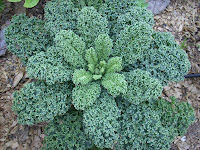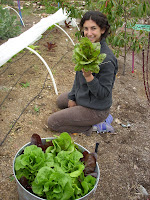According to Chinese Medicine’s Five Element system, the winter season is associated with water (element), fear (emotion), salty (taste), and kidney and urinary bladder (body organs). Winter is the strongest yin (cold, dark) time of the year and its climate (rain, fog) makes us seek inner warmth so it’s time to conserve energy (hibernate) and eat warming foods.
Instead of heading outdoors to The Free Farm, I stayed indoors at Yasue’s kitchen to participate in my favorite sport—cooking!—and help prepare lunch for tomorrow’s Greenhouse Barn Raising and One Year Anniversary Celebration. For winter seasonal eating, we prepared soup and salad featuring miso (fermented soybeans, high in protein and especially good for the circulatory and digestive organs) and radish (which helps dissolve fat and mucus deposits). Tree obtained Seasonal, Local, Organic and Whole (SLOW) food donations from Bi-Rite Grocery: thanks!!!
Like Water, For Stone Soup
Without food, we can survive for weeks, but without water we die of dehydration in a few days. Our body’s water needs vary, depending on our physical activity and diet, but an average 10 cups a day is recommended. We get about 80% of our water from beverages, 20% from foods.
Water makes up 60-70% of our human body, 80% of brain tissue, and 90% of blood. Water is needed to digest food, transport food’s nutrients to tissues, eliminate body wastes, circulate body fluids, lubricate joints and internal organs, and regulate body temperature.
Yasue, who has her own catering business (www.pachamanacafe.com/), showed us how to make a long-simmering miso-root vegetable soup. She explained that the traditional soup recipe includes pork, but omitted since only vegan food is served at The Free Farm to accommodate most people’s dietary needs (e.g., observant Jews and Muslims do not eat pork). In the absence of pork, the soup stock was rich in protein from miso (fermented soybeans), minerals from kombu (kelp) and heat-generating from sake (rice wine). Yasue also added shiitake mushrooms, which help the body discharge excess salts and animal fats. Here’s Yasue’s soup recipe:
Soup stock: water, kombu (pre-soaked), shiitake mushroom (pre-soaked), miso, sake
Chopped vegetables: burdock, carrots, daikon (radish), yellow onions, satsumaimo (sweet potato)
Hand crumbled konnyaku (jelly from wild mountain yams)
Sliced ginger root & scallions



SLOW Food Menu
Alena (j.alen.nye@gmail.com), a personal chef who has been volunteering at The Free Farm since last April, came over to make a colorful salad of baked delicata squash in miso-harissa sauce with kale, radishes and almonds. Kale, along with collard and mustard greens grown at The Farm, score highest on the aggregate nutrition density index (ANDI from
www.eatrightamerica.com/andi-superfoods).


In addition to soup and salad for tomorrow’s lunch, Alena plans to bring home-baked vegan chocolate chip cookies and Yasue plans to make musubi with shiso (beefsteak plant or perilla, which is used in Chinese medicine to boost the body’s immune system).
Yasue, Alena and I were taught cooking by the best teachers—our Mothers! Yasue focuses on traditional Japanese and macrobiotic; Alena specializes in health recovery, dietary needs, allergies, organic baby foods, vegan/vegetarian and locavore; and I like SLOW food cooking with Chinese herbs. Traditional foods are our best medicine, having survived the test of time.
Like Salt, For Minerals
Most water is actually salty: in our bodies and in sea vegetables, water contains many mineral salts. The U.S. Recommended Daily Allowance for salt intake is 1 teaspoon of table salt per day, which includes all salt and sodium consumed, in cooking and at the table. Most Americans, who consume a highly processed Standard American Diet, eat too much salt.
According to TCM, too much salt will “injure the blood,” which relates to the Fire element and heart, directly affecting the kidneys. Kidneys function to maintain water balance and acid-base balance. Studies have shown that too much salt causes water retention, high blood pressure, kidney and heart problems.
Eat SLOW foods that support kidney and bladder functions: whole grains, beans, root vegetables, mineral-rich greens, small amounts of salt fermented foods (pickles, miso, sauerkraut; tamari/shoyu should be used only in cooking, not added to foods at the table). Avoid too much salt and fatty foods (red meat, hard cheese), which cause contraction of kidneys and can lead to high blood pressure or depression.
Finally, the American Dietetic Association has noted that foods such as soybeans, cruciferous vegetables and sweet potatoes contain natural goitrogens, but these foods have not been associated with thyroid insufficiency in healthy people provided iodine intake is adequate. So remember to eat iodine-rich sea vegetables (kelp in soup, nori wrapping in musubi) as part of tomorrow’s lunch!
“Let food be thy medicine and medicine be thy food.”--Hippocrates
 Edible bouquet
Edible bouquet Harvesting yacon root
Harvesting yacon root Covering sides of greenhouse
Covering sides of greenhouse Planting bamboo grove
Planting bamboo grove Kale ready to harvest
Kale ready to harvest
 Gratitude circle around veg lunch spread prepared by Getup grads
Gratitude circle around veg lunch spread prepared by Getup grads Bolivians treat diabetics with yacon root
Bolivians treat diabetics with yacon root Pancho is earth-friendly
Pancho is earth-friendly Our lunch covers 4 food groups: grains, legumes, vegetables & fruits
Our lunch covers 4 food groups: grains, legumes, vegetables & fruits Stanley weighs & Sophie records produce
Stanley weighs & Sophie records produce Tree shows how to propagate his namesake :-)
Tree shows how to propagate his namesake :-) Tree fuses apricot scion with peach rootstock = apreach or peacot?
Tree fuses apricot scion with peach rootstock = apreach or peacot? Tree secures grafted tree with recycled ribbon
Tree secures grafted tree with recycled ribbon Ricardo holds branch in mouth while slicing plucot tree. Check out Ricardo's musical talent at http://rotaciondeceres.com/ & http://www.jovenabuelo.cl/
Ricardo holds branch in mouth while slicing plucot tree. Check out Ricardo's musical talent at http://rotaciondeceres.com/ & http://www.jovenabuelo.cl/










































